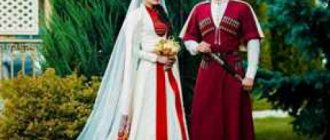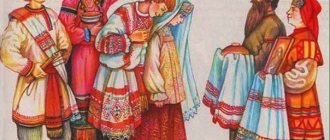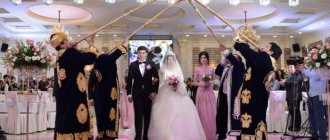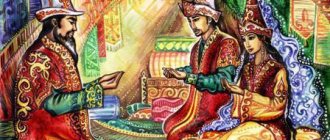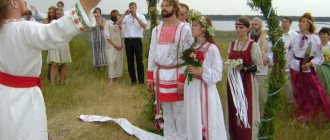A Korean wedding is distinctive and embodies the unique culture of this people with a complex history. Established traditions are very important for Koreans; breaking them means bringing shame and misfortune upon yourself and your family. Modern wedding rituals in Korea are a fusion of customs and modern trends that have been revered for thousands of years, formed relatively recently, in the 50s of the last century.
In some aspects of the wedding ritual, modern young people have received the greatest possible freedom. For example, more and more families are being created out of mutual love, and not through the collusion of older relatives. But the ancient ban on the marriage of people with the same “phoy” - the designation of a branch of the family, simply put, namesakes, is still unshakable. Even if family ties have been lost for decades or even centuries, the boy and girl will not receive permission to marry. In the eyes of others, they were and remain close blood relatives.
Ancient customs of the Korean people
The Korean people have very strong family ties. They absorb honor and respect for elders from childhood, along with fairy tales and legends. Signs, beliefs and a penchant for mysticism permeate all areas of life. Particular attention is paid to everything related to family and children. Until now, in Korea it is not considered something out of the ordinary to consult a fortuneteller about the most favorable day and hour for a wedding. And in ancient times, choosing the time of wedding celebrations was a very responsible matter and could not be done without the help of a venerable fortuneteller.
Weddings - chunme - were played by agreement between families; in most cases, the young people did not even see each other until the wedding ceremony. The youth's older relatives themselves, or with the help of a matchmaker, looked for a couple among suitable girls who had reached marriageable age. Moreover, the requirements for the future bride were quite strict. Not only character, beauty, physique and ability to behave were taken into account, but also equal social status, family wealth, reputation and skills. For their part, the girl’s parents could have made matchmakers from an unwanted family.
What do they give to newlyweds at a wedding in Korea?
In the modern world, Korean weddings, the traditions and customs of which have existed for centuries, are increasingly beginning to adopt European trends. This was also reflected in the gifts that are usually given to newlyweds for their wedding. Today, it is customary for newlyweds to give an envelope with money at a wedding; the amount will depend on how respectful the guest is to the newlyweds and how happy he is with their union.
Since over the past few decades, traditions have gradually begun to fade into the background, and material values have come to the fore, it is quite difficult to say what exactly, besides money, can be given to newlyweds at a Korean wedding. The groom's parents usually must give the young spouses an apartment or house where they can live as a separate family, and the bride's parents must completely furnish this house or apartment. Also, close relatives of a young couple can give gifts that will be useful to the newlyweds in everyday life: watches, dishes, etc.
Preparatory period of Sangyeongne
Modern Korean boys have the opportunity to meet and communicate with girls they like, which was considered obscene until the 60s of the last century. Often, a professional matchmaker is hired to find a soul mate. The most favorable period for marriage is considered to be from 24 to 27 years.
Before starting a serious relationship, young people notify their parents or older relatives of their serious intentions. In Korea, it is believed that the experience and wisdom of the older generation will prevent you from making a mistake and throwing in your lot with an unsuitable party. The search for a future spouse and the assessment of his or her qualities are treated with the utmost care, because divorce in Korea is almost unthinkable.
First acquaintance and matchmaking ritual
Since a wedding in Korea is a matter of great importance, with a lot of nuances, both families are given time to prepare. As a rule, at least six months pass from the moment of agreement to the actual wedding celebrations. If the parents come to an agreement at the preliminary sogethin meeting, the young man’s family can begin the matchmaking ritual.
Matchmakers are usually appointed by close senior relatives of the young man: father, uncles, older brothers. The main thing is that they have an odd sacred number - 3, 5 or 7. Candidates must have a positive outlook on life and be distinguished by worldly wisdom. This is a great honor and considerable responsibility, so there is an unspoken struggle for the place of matchmaker. As a rule, the most respected members of the clan are chosen.
Matchmakers come to the house of the bride's parents and discuss the upcoming celebrations, as well as the nuances of future family life.
Meeting the parents of the newlyweds before the wedding
Despite the fact that Korea is a fairly progressive and developed country, and young people there have long had the right to choose their soulmate with whom they plan to connect their lives, there is one tradition. It is called “sogethin” and implies a meeting between the parents of both newlyweds to get to know each other.
This tradition is not just an act of politeness, at such a meeting the future of the newlyweds is discussed, and what participation each of the parents will take in it, financial wedding issues are also discussed. In addition, at such meetings, parents can exchange medical examination certificates for their children, since Koreans take the birth of healthy offspring quite seriously.
There is one more nuance that is necessarily discussed at such meetings, this is the family background of the future spouses - mon. Pon is a family estate, which is inherited through the male line and represents a kind of settlement association. If it turns out that the newlyweds are from the same Pon, they will not be able to get married, in which case everything is cancelled. If the young people are from different backgrounds, their health is fine, and the parents were able to come to a common agreement regarding the organization of the wedding and the future fate of the future family, then soon matchmakers are sent to the bride.
“Little wedding” or bridesmaid ceremony
At the request of the girl’s older relatives, families can hold a “chenchi”, a preliminary wedding in a narrow circle, after which the newlyweds are already considered husband and wife. And later there are big celebrations. At this wedding, which always takes place in the bride's house, the groom goes through a series of difficult tests. They ask him tricky questions, make fun of him and put him in an awkward position.
Representatives of the groom's family present the girl with rich gifts: luxurious fabrics, jewelry, household items and clothing. At the same time, you won’t be able to get away with just one general gift. Each of those present must give personally, with obligatory good wishes. The next day, the bride presents reciprocal gifts to all participants in the small wedding.
On the eve of the wedding, a small feast for close relatives is held at the groom's house. Having tasted the treat and accepted congratulations, the groom kneels in a respectful position and bows low to his parents, thanking them for their birth and upbringing. Thus the young man enters adulthood.
Matchmaking of a Korean bride
After a successful acquaintance, the groom can send matchmakers to the bride. The groom's father, uncles and accompanying persons act as matchmakers. The main thing is that their number must be odd, which is very important for Koreans. The attendants are called "wushi" and the main requirement for them is the ability to sing, joke and dance. Relatives of a young person, as well as divorced people, who can bring misfortune to a future young family, cannot be included in the number of “wushi”. Matchmakers, who are considered very honorable, go to the bride’s house, where all the nuances of the upcoming wedding celebration, as well as the future life of the newlyweds, are discussed.
Traditional wedding celebrations
Marriage in Korea is usually carried out at home, on the territory of the bride’s family nest. The newlyweds dress in traditional or classic costumes - as desired. They are brought to the site equipped in the courtyard in special “gamma” niches, decorated with peonies. After the wedding ceremony is over, the newlyweds bow deeply to each other and drink wine.
Bride ransom
Before the ceremony begins, the groom must ransom the bride. This custom has ancient roots and is still observed today, taking on a more modern form. In the yard and on the doorstep, the guy is met by numerous single relatives and girlfriends of the girl. They all need to be buttered up with gifts. Little ones are bribed with sweets, but older ones won’t refuse money. Only after breaking through the human cordon can the groom finally enter the house and see his bride. If the “wushi” accompanying the groom has a good tongue and can talk the people out, then the size of the ransom is significantly reduced. Sometimes, if you are lucky or the “usi” reveals something interesting, the girl can be given away without any financial ransom at all.
Another way to get through to a girl without leaving half of your fortune in the pockets of numerous petitioners is to fight with one of her older brothers. Now it is more of a stylized performance, providing a lot of positive emotions to both the participants in the “battle” and the audience. Previously, the duel was intended to test the real military skills of the groom, his ability to protect his beloved and children.
Celebration at the bride's house
When the ransom is received from the groom, the whole company sits down at the table. The newlyweds are seated in places of honor, guests and relatives are seated according to their position. The girl is given good advice and instructions: to be an exemplary housewife, to obey her husband. During the feast, the girl's dowry is given to the groom. After the end of the small feast, the whole company, together with a rich dowry, moves together to the groom's house.
Wedding feast
Favorite performers are usually invited to provide musical accompaniment to the banquet. Sometimes relatives and guests themselves can create a concert program, an amateur performance, so to speak. However, they do not deny themselves the pleasure of singing or dancing on stage, even in the presence of professional singers and groups. This kind of pastime is considered the main highlight of a Korean wedding. Each speaker, even if a bear has stepped on his ear and trampled on his feet, is rewarded with a storm of applause - for his efforts.
Gifts for young people, as in the East in general, are money in all forms: cash in envelopes, checks, gift certificates, and the like. It is not customary to give household appliances or vases and dishes of your choice purchased in stores for a wedding, and this happens extremely rarely.
The tables are literally bursting with a variety of goodies. Elite drinks, plentiful snacks, hot dishes, exotic fruits and sweets of all kinds are an indicator of prosperity and a guarantee of a future comfortable life for the young. A whole boiled rooster must be present. Usually all food is purchased at the expense of the groom's family, this is how they demonstrate wealth.
Kissing at weddings in Korea is not only discouraged, but also prohibited by law. The maximum that young people can afford amid cries of “Bitter!” - This is eating a piece of marmalade or date together.
Festive banquet
A wedding banquet at a Korean wedding nowadays is not much different from a banquet at European weddings. Many traditions, unfortunately, have been lost over many decades. Many Korean celebrity weddings are entirely European in nature, with a standard outdoor ceremony and a buffet-style banquet; the entire event is very modest and discreet. Many newlyweds like to invite famous musicians to their wedding to provide pleasant musical accompaniment to the celebration. Since there is no entertainment program usual for our people at the banquet, a Korean wedding does not provide for a toastmaster. Usually he is replaced by close relatives or parents of the newlyweds, who themselves can sing, dance or show various funny miniatures to the guests.
As for the menu and dishes that must be present at a Korean wedding table, there are several obligatory dishes: noodles and rooster. The presence of noodles is necessary because it is a symbol of the newlyweds' long life together. A whole red chili pepper, decorated with multi-colored threads and shiny tinsel, is usually inserted into the bird’s beak, since pepper, according to Korean beliefs, protects against evil spirits; colorful tinsel is a symbol of the bright life of future spouses.
A rooster at a Korean wedding must be boiled whole, and it must also be served whole. Many banquets also feature traditional dishes such as tteok, bulgogi and galbi. However, recently the presence of European dishes on Korean wedding tables has become increasingly visible.
Wedding signs and traditions of the Korean people
The culture of each people is the quintessence of the invaluable experience of hundreds of generations living in the same territory. The wisdom of the ancestors is expressed in unspoken customs that are not written down anywhere, which, nevertheless, are sacredly observed.
- Family for Koreans is sacred. A man or woman who had not found a mate before the age of thirty was considered strange. They tried to marry such people as quickly as possible with the first more or less suitable candidate. A wedding in Korea is a union of two families, and not just a marriage between young people, so they are very picky when choosing a couple.
- The parents of the future couple meet on neutral territory, usually in a restaurant, where a preliminary acquaintance of the families takes place. Mutual requirements for candidates are put forward, psychological portraits of young people are discussed. A mutual report on physical condition, with the presentation of certificates, is also one of the mandatory points. After all, the health of future grandchildren depends on this! Only after this is a decision made: to have a wedding or not.
- Exactly 70 days before the wedding, the girl must give the family of her betrothed a piece of silk. In the old days, such a gift was truly precious and personified respect for new relatives. Nowadays, fabric is very often replaced with any other fairly valuable gift.
- About a week before the wedding, the groom presents a gift to the bride's family. Traditionally, this was a box in which blue and red silk was placed for the girl's wedding attire. Also, a letter was transmitted from the father or older relative, in which he thanked the girl’s relatives for agreeing to marry their daughter.
- There should be no divorced men among the matchmakers, so that their unhappiness is not passed on to the newlyweds.
- At the entrance to the betrothed's house, a bag of rice and a silk carpet are waiting for the bride - symbols of wealth and prosperity. The girl must step over without tripping and walk across the fabric without knocking it down.
- The young wife and her mother-in-law should look into the mirror they brought with them to avoid mutual mistrust or enmity.
Koreans believe that careful adherence to ancient traditions will give young people a happy and trouble-free life.
Dating Korean newlyweds
Although today an agreement about the upcoming wedding does not happen behind the backs of the newlyweds, parents play a significant role in their fate. They make sure to find out all the information about the bride or groom and only after that give their blessing for the Korean wedding.
The fate of the young people is decided at a meeting called “Sogethin”. It takes place on neutral territory, which is often a restaurant. It is there that the parents of the young people meet and their acquaintance occurs. Often at such meetings, pre-prepared medical certificates are exchanged indicating the state of health of the young people. This is due to the fact that Koreans place great emphasis on the health of their future offspring. And after this, the girl’s parents decide whether she will marry a Korean or remain a girl.
Life just begins after the wedding
The morning after the wedding, the girl must show what a skilled housewife she is: prepare breakfast for the whole family and clean the house or apartment. At breakfast, all the new relatives gather, to whom the young woman presents the gifts she brought with her from her parents’ house.
A modern Korean wedding most often ends with a romantic trip to interesting places and abroad. Returning from a trip, the newlyweds always visit the girl’s parents’ house, where they thank their mother and father and spend the night. The next morning, everyone has breakfast and pays a visit to the young husband's parents, bringing with them traditional Korean dishes as a sign of respect and family unity.
Traditional Korean wedding: choosing a partner
Modern Korean youth meet and choose a companion on their own, but this was not always the case. The head of the family, the father, used to choose a bride for his son, guided by the position and status of the girl’s family. Nowadays, such a custom is rare, mainly in wealthy Korean families who want to tie ties with an equally status family.
Wedding preparations
They prepare for a wedding in Korea very carefully. First of all, gifts are collected from the groom's relatives for all the bride's relatives and friends. These gifts are given from a specific person, and not from the entire family. The following are used as gifts:
If the wedding day has not been set, then the main celebration coincides with the chenchi, and the mini-wedding turns into a real full-fledged celebration. Whose side (the bride or groom) is celebrating the chenchi is decided by the elders during matchmaking. If this right is granted to the bride’s side, then all relatives and friends, colleagues, neighbors, and friends will be invited. If the chenchi is hosted by the groom's side, then the bride's relatives will have to organize a return reception, where the wedding day (if one will be held) will be set.
A return reception is necessary in order to thank those representatives of the groom's family who gave gifts to the bride and her relatives.
Clothing and photos
Part of the time, the newlyweds will be dressed in traditional clothes - hanbok (blue for the groom and red for the bride), and this is incredibly romantic and beautiful, as it symbolizes “yin” and “yang”. But Korean girls love white dresses with lace no less!
The wedding services industry here works like clockwork. The “seu-deu-meh” service greatly simplifies the ceremony, and absolutely all Korean newlyweds can afford luxurious photo shoots. It's simple: dresses, tuxedos and accessories are available for rent, and Korean women are lucky with uniform sizes. So, if you wish, you can choose not just one look, but several at once. Specialists will help with hair styling and makeup.
Of course, photographs will also be taken at the wedding, but it is very convenient not to be distracted by endless posing and shoot your love story in the city or outdoors in advance.
How does matchmaking and engagement work?
Before deciding on the need to marry a boy and a girl, the groom's parents collect all the information about the bride's family. Only after learning details about her ancestors, close and distant relatives and, of course, her parents, does the young man’s father send matchmakers to the house of his future daughter-in-law.
This happens a few weeks before the wedding is scheduled. First, the groom's parents make an appointment with the bride's mother and father. This meeting is taking place on neutral territory. Most often they choose a restaurant or a country cafe.
Here the elders talk, present each other with pre-prepared certificates about the state of health of the young people and the absence of hereditary diseases. This step is a manifestation of concern for the health of future children.
After this, the degree of possible relationship is determined and a decision is made on the possibility of creating a new family.
The reason for refusing the intention to enter into marriage between a boy and a girl may be their belonging to the same family.
The family name inherited through the male line must not be the same. Otherwise, there can be no question of marriage. The role of matchmakers is the groom himself, his father and uncle, who come to the bride’s house accompanied by men who must know how to sing, dance and joke well.
Matchmaking in Korea is a dress rehearsal for the wedding. Close relatives and those who have separated from their spouse by filing a divorce are prohibited from attending here.
Such people can bring misfortune to the home of the young.
Another important condition for successful matchmaking is the number of accompanying people. It doesn't have to be even. According to Koreans, even numbers bring bad luck.
Only close relatives gather at the house of the bride's parents, and the matchmaking takes place without a lavish dinner.
The elders agree by discussing:
- holiday details;
- number of invitees;
- ransom amount;
- bride's dowry.
The main question that the matchmakers and the girl’s parents have to answer is what day the wedding will take place.
They choose only odd numbers and try not to schedule a ceremony during a leap year.
Matchmakers bring with them a treat consisting of expensive alcohol, boiled chicken (or other poultry) and vegetable salad.
Money, jewelry and sweets are given as gifts. Only after the gifts have been distributed and everyone present has tasted the food does a serious conversation begin.
The first set date is the day of the mini-wedding. If after matchmaking a boy and a girl are called bride and groom, then after this event takes place, they are allowed to be called husband and wife.
The groom's mother is also present at the chenchi (mini-wedding), but she is not allowed to take part in the matchmaking.





